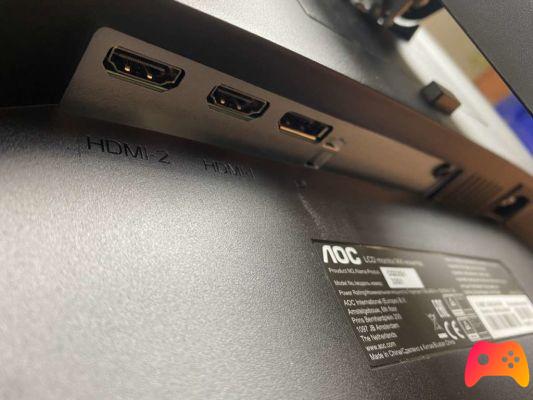We all know AOC by now. For the uninitiated, this is a Taiwanese company specializing in the production of monitors dedicated to the gaming world, particularly attentive to the needs of the gamer, and which always tries to offer the best product at the best price.
After reviewing several AOC monitors, especially in the variants with a 27 "diagonal, today we are here with a product that exceeds the size that we are now used to finding in gaming monitors, making it also suitable for those people who, in addition to gaming, they use the PC for business purposes. We are talking about AOC CQ32G1, 32 ″ diagonal monitor with 1800R curvature, 144Hz refresh rate, 4ms GTG response time and 1ms MPRT, VA type panel, and AMD FreeSync technology support. Unfortunately we find the HDR technology absent, but this is understandable since it is a cheap monitor, always if you want to call it so.

The monitor will arrive in a completely black package, where on both sides we will find an image of the model in question with its initials. The bundle that we will find inside is complete and will allow us to make the most of the monitor right away: in addition to AOC CQ32G1, the package contains the support base (divided into two pieces), the power cable, a Display Port 1.2 cable, an HDMI 2.0 cable and a brief instruction manual.

Although we are faced with a monitor with a 32-inch diagonal panel, AOC CQ32G1 turns out to be extremely compact, thanks to the very minimal frames, which almost give the feeling of having a 27 ″ monitor in front of it. Indeed, both right and left, the bezels are just 5 millimeters thick.
The lower part is instead characterized by a black plastic frame, thicker than the others: this is because below it we find the power button, the keys to navigate within the OSD menu, to change source and to turn the volume up and down. This frame is also embellished with a red border and the AOC logo in gray in the center.

The back of the AOC CQ32G1, unlike the front, is very beautiful to look at and perfectly embodies the player's DNA, because it is very flashy. A real shame considering that most people put the monitor in front of the wall of their room. The body is completely in plastic and the predominant color is black, as for the rest of the monitor, but on the sides we find two red strips that make the design more aggressive, a bit like we have already seen with the other monitors in the family. G of AOC.

At the top we find a small ventilation grid whose purpose is to expel the heat produced by the internal components. Below we find the various IN & OUT ports, consisting of:
- 1 Display Port input;
- 2 HDMI inputs, one of which 2.0;
- 1 audio input with 3,5mm jack;
- 1 input for the power cable.

On AOC CQ32G1, reluctantly, we will not find any USB 3.0 HUB: a real shame, as long as it would have proved extremely convenient especially to connect all those peripherals that will be permanently connected to the PC.
The stand on which we are going to place the monitor is made entirely of plastic and, like the rest of the body, the predominant color is black, embellished with red details. At the bottom of the pedestal we find a hole whose function is to pass the cables that we are going to connect to the monitor, in order to make our workstation precise and tidy. The support base is also made of plastic, but it is extremely solid in order to make everything stable and never shaky. A big flaw of this stand is that it won't allow us to adjust the height of the AOC CQ32G1 or even rotate it: we can only tilt it. This could be a problem if someone has a shelf above the desk, so before buying it take all the necessary measurements or, since AOC CQ32G1 offers support for VESA 100X100 brackets, consider hanging it on the wall.

Although AOC CQ32G1 is an affordable monitor - always considering the generous dimensions - the quality of the panel is really high. On board we find a VA (Vertical Alingment) panel characterized by excellent color coverage and extremely high viewing angles. The panel is of the 8-bit type, capable of reproducing up to 16,7 million colors. AOC CQ32G1 manages to cover up to 120% of the sRGB color gamut and up to 103% of the Adobe one. Static contrast is 3000: 1, while dynamic contrast is 80M: 1 and is able to give even deeper images, while the maximum brightness is 300 cd / sqm. Despite the VA-type panel, it still manages to have viewing angles very similar to those of an IPS monitor. Up to a maximum of 178 degrees, both left and right, the monitor image will be perfect, without looming in color distortions. The curvature of the 1800R panel manages to involve us even more in the game or movie we are watching, but when we have to do some precision work with Autocad or Photoshop, it can sometimes annoy us. After all, it is a gaming monitor, which can also be used (but not designed for) productivity.

The resolution is WQHD, so 2560 × 1440 pixels, ideal for a monitor with these generous dimensions, where the various pixels are not noticed with the naked eye. As with any self-respecting gaming monitor, the refresh rate is 144 Hz and is flanked by technology AMD FreeSync, capable of making images smooth even when you have a low FPS value. This technology will vary the monitor refresh rate depending on the number of FPS that our video card will feed it. AMD FreeSync works in a range between 44 and 144 Hz in order to completely eliminate the annoying screen tearing.
Having a monitor with a high refresh rate, as well as making the gaming experience more fluid, will also help us to strain our eyes less and therefore to withstand much longer and more intense gaming sessions. This is possible because on the monitor we will not see the usual 60 FPS that we are used to seeing with a 60 Hz panel, but rather 144. AOC, for its CQ32G1, has managed to maintain an extremely low input lag in order to make images even more fluid and responsive: we will have just 1 ms of MPRT delay, while the overall one will settle to just 4 ms, thus avoiding the ghosting effect, i.e. the creation of trails during gaming sessions.

We analyzed the panel of the AOC CQ32G1 using our trusty colorimeter. The range covered by our sample reflects what was declared by the manufacturer, or about 120% of sRGB, in our case 117%. The maximum brightness that we managed to obtain during our tests was 294 cd / m276 in the center of the monitor, while moving to the sides, especially in the lower part of the panel, we noticed a drastic drop, reaching peak brightness equal to XNUMX cd / sqm.
Even in terms of colors, the AOC monitor presents some discrepancies, recording a maximum color difference of 2,53% in the upper right corner. Nothing to worry about, these are trifles that we can only notice using the appropriate tools. A practice that unites all monitors, both with VA and IPS panels equipped with LED lighting, is the Black Light Glow: on AOC CQ32G1 it is present in the four corners of the panel, which are slightly brighter when we are in front of a completely image Black.
As we have already seen with the other AOC monitors already reviewed, also in this case we find the same OSD menu, always well done and which allows us to control all the parameters. Here we find a setting called sRGB which will load us an already calibrated monitor profile, thus returning very realistic colors. Through OSD, in addition to choosing the input source, we can change the brightness, contrast, gamma and position of the image. We also find a nice option that will allow us to emulate HDR technology, in order to make images even more beautiful to see, even if remotely comparable to a native HDR signal.

AOC CQ32G1 is a monitor with both important dimensions and excellent characteristics. The VA panel, combined with excellent sRGB coverage and 8-bit color depth, manages to guarantee vivid and brilliant images. The high refresh rate, and the low pixel response time make the gaming experience truly unique, fluid and that only a PC can offer, unlike consoles that are relegated to their 60Hz and 30fps TVs narrow. If our video card fails to guarantee an adequate framerate, AMD FreeSync will take care of making the images fluid, adapting the refresh rate to the number of FPS generated. AOC CQ32G1 has a solid and robust construction, combined with excellent materials. All very nice, but unfortunately the monitor also has flaws, such as the inability to adjust the height of the panel and the lack of a USB 3.0 hub.
If you are looking for a gaming monitor with a high refresh rate, low response times, great colors and (above all) large, AOC CQ32G1 could be for you, also taking into account the interesting price of around 329 €.
Deprecated: Automatic conversion of false to array is deprecated in /home/epictrick.com/htdocs/php/post.php on line 612






